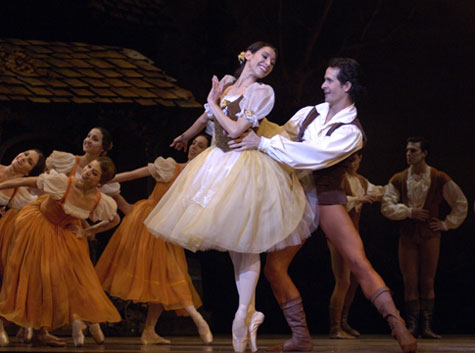
Photo: Eric Antoniou
Erica Cornejo and Nelson Madrigal |
VIEW photos of Giselle at the Opera House. By Eric Antoniou Giselle | Music by Adolphe Adam, Arranged by John Lanchbery | Choreography after Jean Coralli, Jules Perrot, and Marius Petipa | Set and Costumes by Peter | Lighting by Randall Chiarelli | Staging by Maina Gielgud | with the Boston Ballet Orchestra Conducted by Jonathan McPhee | Presented by Boston Ballet at the Opera House through October 11 |
The first thing audiences see when the curtain goes up on Boston Ballet’s
Giselle is our heroine’s charming Rhineland-village home, a rustic abode that in Peter Farmer’s set is framed by birches, a symbol of fidelity. Call it a symbol for the company: like Albrecht, Boston Ballet has forsaken the castle for the cottage, leaving the spacious — even cavernous — Wang Theatre, where it roamed for nearly 30 years, for the more intimate Boston Opera House, to which it’s pledged its troth for the
next 30 years. But unlike Albrecht, whose decision ends in tragedy, the Ballet, on the evidence of last weekend’s opening performances in its new home, is unlikely to regret its decision.
The Opera House is, granted, a pretty fancy cottage: it opened in 1928 as a lavish movie theater and vaudeville palace and was taken over in 1980 by Sarah Caldwell’s Opera Company of Boston before undergoing a $38 million restoration (courtesy of Clear Channel) in 2004. The stage area is slightly smaller than the Wang’s but comparable to what most first-tier ballet companies perform on. The backstage area is much smaller and will test the company’s resources. The acoustics are much better: Jonathan McPhee’s Boston Ballet Orchestra sounds louder, clearer, brighter.
Staging a 168-year-old ballet is in itself an act of faith. This is essentially the same production the company offered in May 2007, right down to the atmospheric lighting and the pair of well-behaved (both casts) Russian wolfhounds that accompany the arrival of the royal hunting party in act one. Woodcutter and hunter Hilarion has his eye — and a claim? — on village girl Giselle, but her heart has been stolen by handsome stranger Albrecht, who pledges his undying love. Albrecht’s hand, alas, is pledged elsewhere: he’s actually a prince, and engaged to a duke’s daughter. When Bathilde visits the village, the truth comes out, and a heartbroken Giselle goes mad and dies. In the celebrated “white” second act, which is set in the birch forest, Giselle is initiated into the Wilis, the marauding shades of women who were jilted by their lovers before their wedding day. Led by their queen, Myrtha, they harry and dispatch the blameless Hilarion and then turn their wrath against Albrecht when he comes to mourn at Giselle’s grave. When Giselle appears to defend Albrecht, Myrtha enjoins the pair to dance out their love, and though they don’t quite satisfy her, they’re still trying when dawn breaks and the Wilis — including Giselle — must disperse, leaving Albrecht with only regrets and memories.